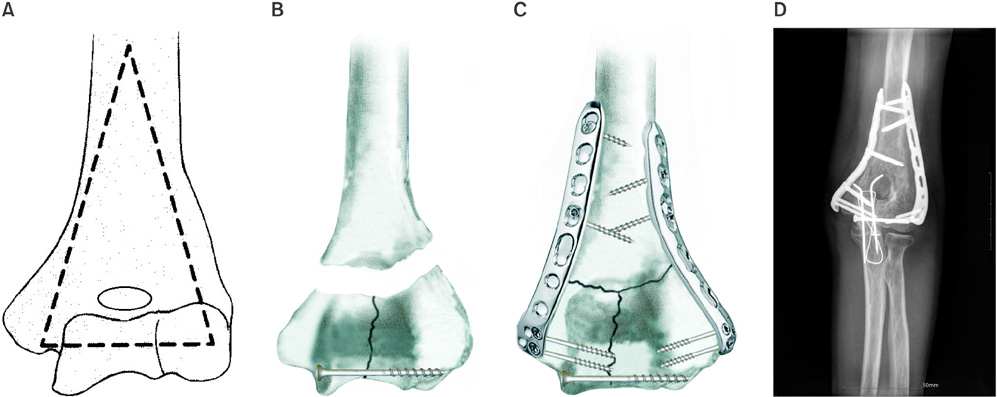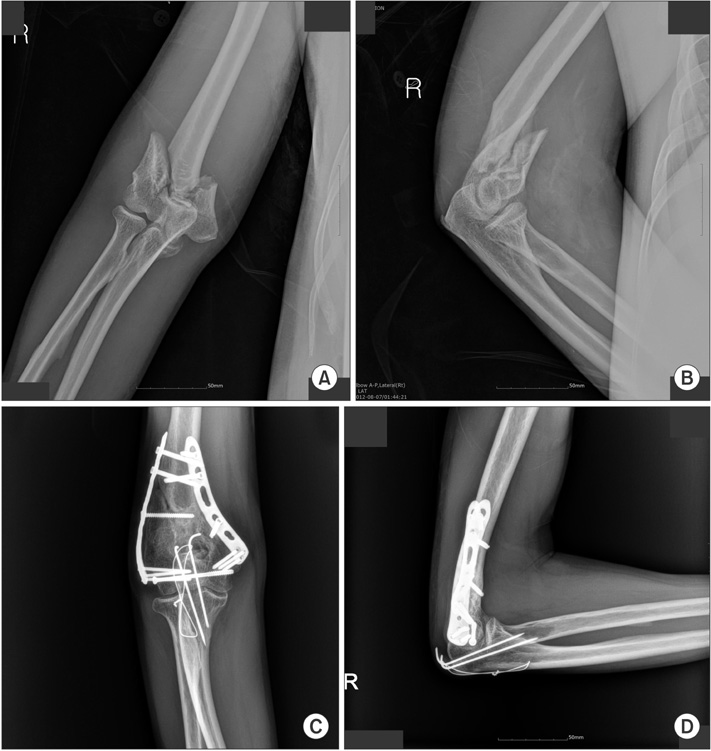Clin Orthop Surg.
2016 Mar;8(1):9-18. 10.4055/cios.2016.8.1.9.
Triangular Fixation Technique for Bicolumn Restoration in Treatment of Distal Humerus Intercondylar Fracture
- Affiliations
-
- 1Department of Orthopedic Surgery, Samsung Changwon Hospital, Sungkyunkwan University School of Medicine, Changwon, Korea. can1204@hanmail.net
- KMID: 2363940
- DOI: http://doi.org/10.4055/cios.2016.8.1.9
Abstract
- BACKGROUND
Distal humerus intercondylar fractures are intra-articular and comminuted fractures involving soft tissue injury. As distal humerus is triangle-shaped, parallel plating coupled with articular fixation would be suitable for bicolumn restoration in treatment of distal humerus intercondylar fracture.
METHODS
This study included 38 patients (15 males and 23 females) who underwent olecranon osteotomy, open reduction and internal fixation with the triangle-shaped cannulated screw and parallel locking plates (triangular fixation technique). Functional results were assessed with the visual analog scale (VAS) scores, Mayo elbow performance (MEP) scores and Disabilities of the Arm, Shoulder and Hand (DASH) questionnaires. Anteroposterior and lateral elbow radiographs were assessed for reduction, alignment, fracture union, posttraumatic arthrosis, and heterotopic ossification, and computed tomography (CT) scans were used to obtain more accurate measurements of articular discrepancy.
RESULTS
All fractures healed primarily with no loss of reduction. The mean VAS, MEP, and DASH scores of the affected elbow were not significantly different from those of the unaffected elbow (p = 0.140, p = 0.090, and p = 0.262, respectively). The mean degree of flexion was significantly lower in the affected elbow than in the unaffected elbow, but was still considered as functional (p = 0.001, > 100degrees in 33 of 38 patients). Two cases of articular step-offs (> 2 mm) were seen on follow-up CT scans, but not significantly higher in the affected elbow than in the unaffected elbow (p = 0.657). Binary logistic regression analysis revealed that only Association for Osteosynthesis (AO) type C3 fractures correlated with good/excellent functional outcome (p = 0.012). Complications occurred in 12 of the 38 patients, and the overall reoperation rate for complications was 10.5% (4 of 38 patients).
CONCLUSIONS
Triangular fixation technique for bicolumn restoration was an effective and reliable method in treatment of distal humerus intercondylar fracture. This technique maintained articular congruency and restored both medial and lateral columns, resulting in good elbow function.
MeSH Terms
Figure
Reference
-
1. Sanchez-Sotelo J, Torchia ME, O'Driscoll SW. Complex distal humeral fractures: internal fixation with a principle-based parallel-plate technique. J Bone Joint Surg Am. 2007; 89(5):961–969.2. Muhldorfer-Fodor M, Bekler H, Wolfe VM, McKean J, Rosenwasser MP. Paratricipital-triceps splitting "two-window" approach for distal humerus fractures. Tech Hand Up Extrem Surg. 2011; 15(3):156–161.
Article3. Kaiser T, Brunner A, Hohendorff B, Ulmar B, Babst R. Treatment of supra- and intra-articular fractures of the distal humerus with the LCP Distal Humerus Plate: a 2-year follow-up. J Shoulder Elbow Surg. 2011; 20(2):206–212.
Article4. Pajarinen J, Bjorkenheim JM. Operative treatment of type C intercondylar fractures of the distal humerus: results after a mean follow-up of 2 years in a series of 18 patients. J Shoulder Elbow Surg. 2002; 11(1):48–52.
Article5. Mansat P, Nouaille Degorce H, Bonnevialle N, Demezon H, Fabre T. SOFCOT. Total elbow arthroplasty for acute distal humeral fractures in patients over 65 years old - results of a multicenter study in 87 patients. Orthop Traumatol Surg Res. 2013; 99(7):779–784.
Article6. Stoffel K, Cunneen S, Morgan R, Nicholls R, Stachowiak G. Comparative stability of perpendicular versus parallel double-locking plating systems in osteoporotic comminuted distal humerus fractures. J Orthop Res. 2008; 26(6):778–784.
Article7. O'Driscoll SW. Optimizing stability in distal humeral fracture fixation. J Shoulder Elbow Surg. 2005; 14:1 Suppl S. 186S–194S.8. Green A. Postoperative management after open reduction and internal fixation of distal humeral fractures. Instr Course Lect. 2009; 58:535–539.9. Huang JI, Paczas M, Hoyen HA, Vallier HA. Functional outcome after open reduction internal fixation of intra-articular fractures of the distal humerus in the elderly. J Orthop Trauma. 2011; 25(5):259–265.
Article10. Athwal GS, Hoxie SC, Rispoli DM, Steinmann SP. Precontoured parallel plate fixation of AO/OTA type C distal humerus fractures. J Orthop Trauma. 2009; 23(8):575–580.
Article11. Broberg MA, Morrey BF. Results of delayed excision of the radial head after fracture. J Bone Joint Surg Am. 1986; 68(5):669–674.
Article12. Nauth A, McKee MD, Ristevski B, Hall J, Schemitsch EH. Distal humeral fractures in adults. J Bone Joint Surg Am. 2011; 93(7):686–700.
Article13. Arnander MW, Reeves A, MacLeod IA, Pinto TM, Khaleel A. A biomechanical comparison of plate configuration in distal humerus fractures. J Orthop Trauma. 2008; 22(5):332–336.
Article14. Zalavras CG, Vercillo MT, Jun BJ, Otarodifard K, Itamura JM, Lee TQ. Biomechanical evaluation of parallel versus orthogonal plate fixation of intra-articular distal humerus fractures. J Shoulder Elbow Surg. 2011; 20(1):12–20.
Article15. Worden A, Ilyas AM. Ulnar neuropathy following distal humerus fracture fixation. Orthop Clin North Am. 2012; 43(4):509–514.
Article16. Ring D, Gulotta L, Chin K, Jupiter JB. Olecranon osteotomy for exposure of fractures and nonunions of the distal humerus. J Orthop Trauma. 2004; 18(7):446–449.
Article17. Reising K, Hauschild O, Strohm PC, Suedkamp NP. Stabilisation of articular fractures of the distal humerus: early experience with a novel perpendicular plate system. Injury. 2009; 40(6):611–617.
Article18. Morrey BF, Askew LJ, Chao EY. A biomechanical study of normal functional elbow motion. J Bone Joint Surg Am. 1981; 63(6):872–877.
Article
- Full Text Links
- Actions
-
Cited
- CITED
-
- Close
- Share
- Similar articles
-
- Intercondylar Fracture of Distal Humerus in Children
- Clinical Study for Humerus Intercondylar Fracture in Adult
- Treatment of comminuted distal humeral intercondylar fracture using transolecranon approach
- Refracture of Forearm Bone after Plate Removal
- Comminuted Intercondylar Fracture of the Distal Humerus in Adults




